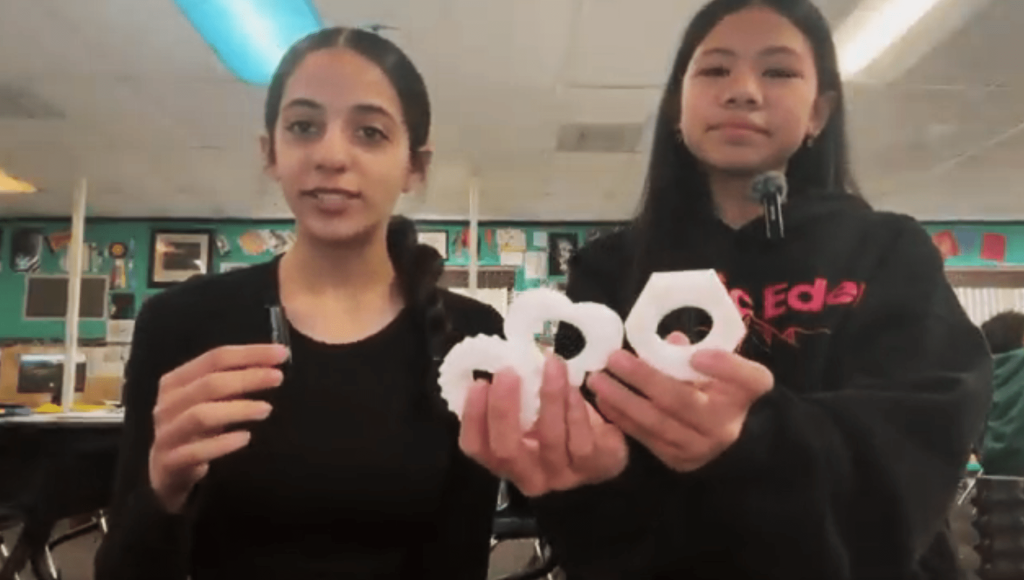
Two very talented students at Spring Valley Academy in the La Mesa-Spring Valley school district got exciting news this week.
Isabelle Kalasho and Mariella Ferrer, 8th graders are enrolled in the school’s Advanced Computer Science class, have been named finalists of the Make:able Challenge, an international 3D Printing design competition run by PrintLab, an online tutorial program used by the class.
PrintLab’s annual 3D printing and assistive technology challenge invites schools around the world to design and submit a 3D printed product that improves the day-to- day life of someone with a disability or the elderly.
This year’s finalists include submissions from Lebanon, Spain, Hong Kong, Malaysia, El Salvador and Brazil – and Spring Valley!
The contest is divided into various age groups and categories ranging from elementary through high school. Isabelle and Mariella – whose team name is ‘Super Helpers’ – advanced to the finals in the Best Showcase of Empathy (Under 14) category.
An international judging panel of specialists in assistive technology, product design, education and 3D printing will vote, and the winners in all categories will be announced on July 1. Full videos showcasing the design journeys and inspiring stories will be shared alongside the announcements.
First Year Success
Spring Valley Academy’s computer science teacher, Bernadette Filippone, only recently introduced her students to PrintLab as this is her first year teaching 3D printing.
When she learned of the Make:able challenge, she teamed up with the school’s Special Education teacher Dave Sipowicz to create designs to help some of his students with specific needs.
“The whole purpose of the challenge is to get students to think about how they can create something using the 3D printer for someone with disabilities or someone in need,” explains Filippone. “The curriculum gives a step-by-step process, including walking the student through interviewing the end user to identify their need.”
Isabelle and Mariella’s student has a sensory learning deficit. “Our idea for our end user was to create a sensory fidget with a spinning component that can go down a stick easily and independently,” says Isabelle. “He [the student] enjoys stuff that has some sort of spinning movement and items that move with the flow,” adds Mariella.
The girls chose three shapes, and the final product took many iterations. “We redesigned the shape to eliminate some corners that were very sharp, making sure the fidget was safe for our end user,” continues Isabelle. “At the end, the result of the project was a success. After many failures, we managed to perfect it.”
Filippone encouraged the girls as they experienced the often-frustrating process of fine-tuning a design while test-printing and adjusting measurements to perfect their creation: “They went through six iterations and were just about to give up because they were running out of time, and I said, ‘You understand what you have to do and you’re off by just one measurement. You can do it!’
“They set the printer up to print over the weekend, and when they came in on Monday morning, it had worked perfectly! They were so excited.”
Documenting The Process / Making The Finals
Part of the challenge was for each team to record each step of the process, from sketching to modeling, and present it all in a video.
PrintLab’s founder emailed Filippone two weeks ago to inform her of Isabelle and Mariella advancing to the finals. “I was beside myself,” she smiles. “I started tearing up. It was amazing.”
Filippone showed the announcement to her class the next morning, scrolling on the PrintLab website, where it revealed the finalists as a surprise. “Everyone’s jaws dropped, and Isabelle and Mariella were so shocked to see their project on the site! But they were so proud, as were their classmates. This is a small class – just 12 kids, including three girls, and this team is just two girls.”
The whole class had a potluck celebration party later that week. And everyone is keeping their fingers tightly crossed for the winning announcements on July 1st.
“We hope this will help others with sensory integration,” concludes Mariella. “We enjoyed this worldwide project and hope this will set an example for others who are also doing this.”

